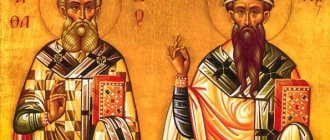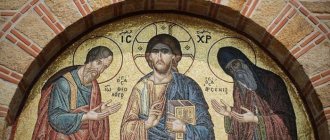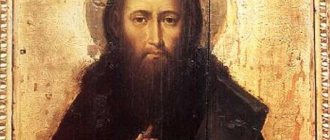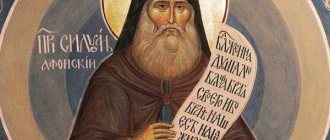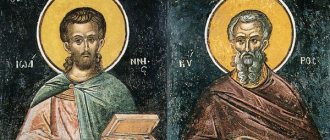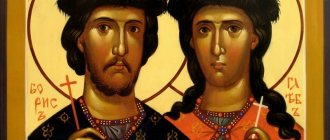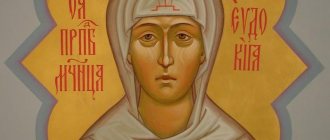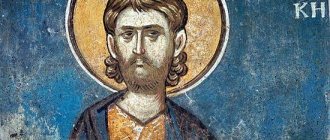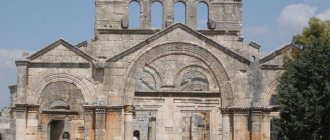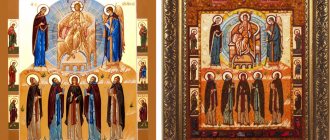| St. Venerable Athanasius of Athos |
Athanasius of Athos
(+ c. 1000), abbot, venerable Commemorated on July 5 and in the Council of the Athos Venerables
In holy baptism, Abraham was born in the city of Trebizond and, orphaned at an early age, was raised by a good, pious nun, imitating his adoptive mother in the skills of monastic life, in fasting and prayer. He comprehended teaching easily and soon surpassed his peers in the sciences.
After the death of his adoptive mother, Abraham was taken to Constantinople, to the court of the then Byzantine emperor Roman the Elder, and assigned as a student to the famous rhetorician Athanasius. Soon the student achieved the perfection of a teacher and himself became a mentor to the youth. Considering fasting and wakefulness to be true life, Abraham led a strict and abstinent life, sleeping little and then sitting on a chair, and his food was barley bread and water. When his teacher Athanasius, due to human weakness, began to envy his student, blessed Abraham left his mentorship and retired.
In those days, the Monk Michael Malein, abbot of the Kiminsky monastery, arrived in Constantinople. Abraham told the abbot his life and revealed to him his innermost desire to become a monk. The divine elder, seeing in Abraham the chosen vessel of the Holy Spirit, fell in love with him and taught him a lot about matters of salvation. One day, during their spiritual conversation, Saint Michael was visited by his nephew Nicephorus Phocas, a famous commander and future emperor. Abraham's high spirit and deep mind impressed Nikifor and inspired reverent veneration and love for the saint for the rest of his life. Abraham was consumed by zeal for monastic life. Having abandoned everything, he arrived at the Kiminsky Monastery and, falling at the feet of the venerable abbot, asked to be clothed in a monastic image. The abbot gladly fulfilled his request and tonsured him with the name Athanasius.
At the monastery, the Monk Athanasius diligently performed monastic obediences, and in his free time he was engaged in rewriting the Holy Books. It is known that he rewrote the Four Gospels and the Apostle.
Through long fasts, vigils, genuflections, night and day labors, Athanasius soon achieved such perfection that in 960 the holy abbot blessed him for the feat of silence in a secluded place not far from the monastery on Holy Mount Athos.
After leaving Kimin, he walked around many deserted and secluded places, including in 963 he lived for six months in the Holy Monastery (Αγία Μονή) near the city of Paphos on the island of Cyprus [1], and, guided by God, came to a place called Melana, on the very edge of Athos, far removed from other monastic dwellings. Here the monk built himself a cell and began to strive in labor and prayer, ascending from asceticism to asceticism to the highest monastic perfection.
The enemy tried to arouse in Saint Athanasius hatred of his chosen place, fighting him with incessant thoughts. The ascetic decided to wait a year, and then do as the Lord arranges. On the last day of the term, when Saint Athanasius began to pray, the Heavenly Light suddenly shone upon him, filling him with indescribable joy, all thoughts dissipated, and blessed tears flowed from his eyes. From then on, Saint Athanasius received the gift of tenderness, and he loved his place of solitude with the same intensity as he had previously hated. At that time, Nikifor Phokas, fed up with military exploits, remembered his vow to become a monk and asked the Monk Athanasius to build a monastery at his expense, that is, to build for him and the brethren cells for silence and a temple where the brethren would partake of the Divine Mysteries of Christ on Sundays.
Avoiding worries and cares, blessed Athanasius at first did not agree to accept the hated gold, but, seeing the ardent desire and good intention of Nicephorus and seeing the will of God in this, he began to build a monastery. He erected a large temple in the name of the holy Prophet and Forerunner of Christ John and another temple, at the foot of the mountain, in the name of the Blessed Virgin Mary. Cells appeared around the temple, and a wonderful monastery arose on the Holy Mountain. A refectory, a hospital, a hospice and other necessary buildings were built in it.
Brethren flocked to the monastery from everywhere, not only from Greece, but also from other countries: ordinary people and nobles, hermits who labored for many years in the desert, abbots of many monasteries and bishops wanted to be simple monks in the Athonite Lavra of St. Athanasius.
The holy abbot established a communal charter in the monastery in the likeness of the ancient Palestinian monasteries. Divine services were performed with the utmost severity; no one dared to talk during the service, be late, or leave the church unnecessarily.
During his holy life, the Monk Athanasius was awarded by the Lord the gift of clairvoyance and miracles: with the sign of the cross he healed the sick and cast out unclean spirits. The Most Pure Mother of God herself, the Heavenly Lady of Athos, favored the saint. Many times he was honored to see Her with sensual eyes.
By God's permission, such a famine occurred in the monastery that the monks, one after another, began to leave the Lavra. The monk was left alone and in a moment of weakness also thought of leaving. Suddenly he saw a Woman under a blanket of air, walking towards him. “Who are you and where are you going?” - She asked quietly. Saint Athanasius stopped with involuntary respect. “I am a local monk,” he answered, and told about himself and his concerns. “And for the sake of a piece of daily bread, you abandon the monastery, which is to be glorified throughout generations and generations? Where is your faith? Turn back and I will help you." - "Who are you?" - asked Afanasy. “I am the Mother of your Lord,” She answered and ordered Athanasius to hit the stone with his rod, so that a spring emerged from the crack, which still exists today, reminding of the wonderful visit.
The number of brethren grew, construction work was underway in the Lavra. The Monk Athanasius, foreseeing the time of his departure to the Lord, prophesied about his imminent death and asked the brethren not to be tempted by what would happen. “For otherwise people judge, otherwise the Wise One arranges.” The brethren were perplexed and pondered over the words of the monk. Having taught his last instructions to the brethren and consoled everyone, Saint Athanasius went into his cell, put on a mantle and a sacred doll, which he wore only on great holidays, and after a long prayer he left. Cheerful and joyful, the holy abbot went up with six brothers to the top of the temple to inspect the construction. Suddenly, by the unknown destinies of God, the top of the temple collapsed. The five brothers immediately gave up their spirit to God. The Monk Athanasius and the architect Daniel
, covered with stones, remained alive. Everyone heard how the monk called on the Lord: “Glory to Thee, God! Lord Jesus Christ, help me!” The brothers, with great weeping, began to dig out their father from under the ruins, but found him already deceased. The death of the saint followed around the year 1000 [2].
| The relics of St. Afanasy of Athos. Athos, Great Lavra. |
Biography of Afanasy Afonsky
Born into a pious family in the city of Trebizond, Saint Athanasius (at baptism he was named Abramius) was distinguished by piety and prudence from childhood. Left an orphan, thanks to his meek disposition and ability to learn, the young man received an excellent education, being brought up in the house of an imperial official. He had a bright future ahead of him.
But luxury and vanity were alien to Athanasius, and he soon took monastic vows in a monastery. All his life he dreamed of solitude, avoiding honor and clergy, even going to the holy Mount Athos to visit the hermits, calling himself Barnabas. There he hid from worldly temptations, offering prayers to God, reflecting on the Kingdom of God.
The fame of the wonderful monk spread throughout the world, and, thanks to his faithful service to the Lord, Athanasius soon managed to build a monastery on Mount Athos with the help of money given to him by his confessor Nicephorus. Soon the Lavra will become a holy place for pilgrims.
However, during the construction of the Lavra, the devil more than once interfered with the holy work, but the Mother of God herself appeared to Athanasius, promising to become the Housekeeper of the monastery. More than once I had to say a prayer to Athanasius of Athos to our Lord so that he would enlighten and help in construction; he even left the site of the future Lavra, but the Lord brought him back.
Many buildings were erected on the Holy Mountain where monks and hermits could study and live. People from all over the world came to the Lavra built by Athanasius to study, hermits went for healing - spiritual and physical.
As the abbot of the monastery, Athanasius lived like a real hermit - modestly, without excesses, helping the sick and orphans, who with hope offered up a prayer to the Monk Athanasius of Athos, thanking him for his wisdom and meekness of soul.
The Reverend died when he once again climbed onto the scaffolding, observing the construction. The unfinished dome collapsed, taking Athanasius and five monks with it. For three hours the monks raked out the rubble, hearing the voice of the Reverend: Glory to Thee, God! Lord Jesus Christ, help me!
However, Saint Athanasius was dead and buried only on the third day, until three thousand inhabitants of the Athos monastery said goodbye to him. His body was not subject to decay, and from the wound received from the fall, holy blood flowed, which the monks collected in a vessel, and it subsequently healed many suffering people.
Prophecy
The most venerable holy father Paul from the monastery of Xiropotamos said prophetic words: “Whoever comes last to the Holy Mountain will be ahead of all the monks in the Kingdom of Heaven, and many will want to be under his leadership.” After this, Archpriest Paul summoned Athanasius for a frank conversation. Having learned the whole truth, he assigned him a secluded cell 4 km from Kareya so that he could be alone with God. And he promised that he would not give him away.
But the monks did not give him peace. They constantly looked to him for advice. Then he decided to go to the southern cape of Mount Athos Melana, where it was deserted and very windy. Here he began to be attacked by Satan. Afanasy held out for a long time, but then he could not stand it and decided to leave this place. Suddenly a heavenly light pierced him, filling him with joy and sending him the gift of tenderness.
Miracles of Athanasius of Athos
Thousands of pilgrims offered prayers to the saint, marveling at the miraculous feats he performed during his lifetime. With his hand he healed the sick, some for a short time, others for many years. The saint also eased the suffering of believers on their deathbed, so many sincere believe in the power of the prayers of Athanasius of Athos for the outcome of the soul, pronouncing them with the hope of forgiveness for the sins of their lives.
Athanasius performed many miraculous deeds: he saved the lives of monks in a strong storm, when the boat almost sank, he healed the possessed, he even cured cancer with one mark of the cross.
Life of St. Athanasius the Great
The revered minister of the Orthodox Church was born in Alexandria at the end of the 3rd century, around 297. Afanasy's parents are laymen from the intelligent class who profess Christianity. He was a capable boy, versed in the exact sciences and humanities and studied Christian rituals following the example of his parents.
Religion was an integral part of people's lives at the dawn of Christianity, which was reflected in children's games. One day, the Bishop of Alexandria saw from his window how Christian children were baptizing pagan children. The boy, in the role of priest, read a prayer as if he were in church. It was young Afanasy. The bishop took over his hidden guardianship, appointed him lecturer, and then elevated him to the rank of deacon.
Athanasius participated in the First Ecumenical Council. The Bishop of Alexandria took the diligent young man with him to Nicaea and ordered him to deliver an indictment against the Arian heresy at the meeting. The young deacon met with the approval of Orthodox Christians. Real Aryans harbor hatred. When Athanasius was elected as the new bishop, heretics tried to disgrace him by any means.
The Arians called Bishop Arsenius of Miletus a holy sorcerer and murderer. Afanasy's opponents presented evidence: a severed hand, presumably belonging to the murdered man. Then the bishop provided live arsenic, which was hiding in Thebias. But at the Council of Tire, Athanasius was unable to prevent the total pressure of the anti-Nicinian people on the Christian bishops. He was deprived of his high rank and sent into exile.
The saint spent two years in the city of Augustus Travers. Upon returning to Alexandria, he was again accused of plundering the church treasury. After the illegal appointment of the Arian priest Gregory Athanasius as bishop, he turned to the Roman Archbishop for help. The saint was acquitted, but returned to Alexandria only after the death of Gregory.
Over the next 10 years, Athanasius went into exile five times. His zealous pastoral activities aroused the wrath of three emperors: Costanzo, Giuliano l'Apostata and Valente. But even from the Egyptian desert the saint had a great influence on believers with his oral and written sermons. Eventually, the bishop regained the confidence of church and government officials in 366. He left his post only after his death in 373.
How do prayers to Athanasius of Athos help?
Many believers know when to read prayers to the holy elder. This is also a prayer for death to Athanasius of Athos, alleviating the final suffering of the dying man. If a person is on the verge of death and life, then they read a prayer in front of the icon of St. Athanasius for a speedy determination of the fate of the patient.
Memorial Day: July 18
Prayers also help those who want to believe, strengthening their spirit and thoughts. Leaders who want to strengthen their authority turn to the saint to give them wisdom and experience. In desperation and difficult situations, they also turn to Athanasius of Athos, asking him to help and reason.
Confessor
For three years, Abraham and Zifinizer were on the shores of the Aegean Sea. Then they returned to Constantinople, where the strategist introduced the young man to Saint Michael Malein. He was the abbot of the monastery on Kiminskaya Mountain. He was respected by all the Byzantine nobility. All these people were conquered by Abraham. And then he spoke about his desire to become a monk. After this conversation, his nephew Nikifor Foka, who was at that time the strategist of the Anatolik theme, came to the Monk Michael, who also immediately took a liking to the pious young man. And then Abraham finally found himself a confessor - the holy elder Michael. He went after him to Kiminskaya Mountain. There he took monastic vows with the name Athanasius.
Prayer to St. Athanasius of Athos
Reverend Father Athanasius, great servant of Christ and great wonderworker of Athos! During the days of your earthly life, you taught many on the right path and wisely guided you into the Kingdom of Heaven, comforted the sorrowful, gave a helping hand to those who fell, and was a kind, merciful and compassionate father to everyone! Even now, dwelling in Heavenly lightness, you most especially multiply your love for us who are weak, in the sea of life, variously distressed, tempted by the spirit of malice and our passions, warring against the spirit. For this reason, we humbly pray to you, holy father: according to the grace given to you from God, help us to do the will of the Lord in simplicity of heart and humility, to defeat the temptations of the enemy and dry up the sea of fierce passions; so let us calmly pass through the abyss of life and through your intercession to the Lord we will be honored to achieve the Kingdom of Heaven promised to us, glorifying the Beginningless Trinity, the Father and the Son and the Holy Spirit, now and ever and unto the ages of ages. Amen.
Iconography
The cult monuments of St. Athanasius have survived to this day. In the Russian Byzantine and Orthodox schools, the minister of the church was depicted on waist icons according to the following rules:
- White hair;
- high forehead;
- wide beard with curly strands;
- dressed in a white robe with black crosses;
- the episcopal attribute on the belt is a “club” scarf in the shape of a diamond with an embroidered cross in the center;
- holding a scroll or Gospel.
Sometimes there are icons with details of the saint’s vestments, emphasizing the dignity of the bishop: an omophorion or a miter.
Athanasius was depicted in full growth on icons associated with the Monk Cyril. Bishop Leonty of Rostov united the saints on a 15th-century Novgorod icon. The figure of the Bishop of Alexandria is inscribed in the image of St. Nicholas with the Deesis among the selected saints. The icon dates back to the 4th century and was also painted by Novgorod masters.
The image of Saint Athanasius was placed on frescoes in ancient churches in Rome, Cappadocia (central region of Turkey), Macedonia, Sicily and Greece. The image of the bishop is present in illustrations on the pages of manuscripts. In one of the ancient drawings, the bishop is immortalized sitting above the composition. Nearby is a table with an open book.
In Cairo's St. Mark's Cathedral, an image of St. Athanasius in a red vestment is painted on top of a reliquary with relics in a niche. The niche is decorated with flowers and a gilded frame.
Second prayer
A great ascetic, an educated Christian, a wise leader and shepherd. Having overcome spiritual melancholy and despondency, he received from God the gift of tenderness and joy. His prayer was powerful both for healing people from illness and for casting out demons and their influence on people. He laid the foundation for communal life on Mount Athos, the construction of monasteries and temples, and social and medical assistance to the sick (lepers). They turn to St. Athanasius of Athos for prayerful help for zeal in faith and ascetic work, in case of despondency (depression), lack of faith, in illness, for protection from demonic attacks. Patron of monks, abbots of monasteries, temple builders. Christians in leadership positions can pray to him for wisdom and authority to serve according to God's word: “The greatest of you shall be your servant; for whoever exalts himself will be humbled, and whoever humbles himself will be exalted.” (Matt. 23:11-12).
Orthodox texts
On the days of memory of St. Athanasius, they are famous for their traditional hymns.
Troparion
- The pillar was your Orthodoxy, divine dogmas confirming the Church, Hierarch Athanasius: preaching consubstantiality to the father of the son, you ignore Arius. Reverend Father, pray to Christ God that he will give us great mercy.
Kontakion
- Having planted the teachings of Orthodoxy, you have thorns of evil, multiplying the seed of faith with the clothing of the Spirit, reverend, we sing the same thing to Athanasius.
Troparion and Kontakion to St. Athanasius of Athos
Troparion, tone 3
Even in the flesh, you were amazed at your angelic life, how you came out with your body to the invisible plexus, ever glorious, and you wounded the demonic regiments; Therefore, Athanasius, Christ rewarded you with rich gifts; For this reason, Father, pray for our souls to be saved.
Kontakion, tone 8
As the viewer’s immaterial beings are quite numerous and active as an all-true storyteller, your flock calls to you, O God-speaker: do not be impoverished, praying for your servants, to get rid of misfortunes and treatment, crying out to you: Rejoice, Father Athanasius.
